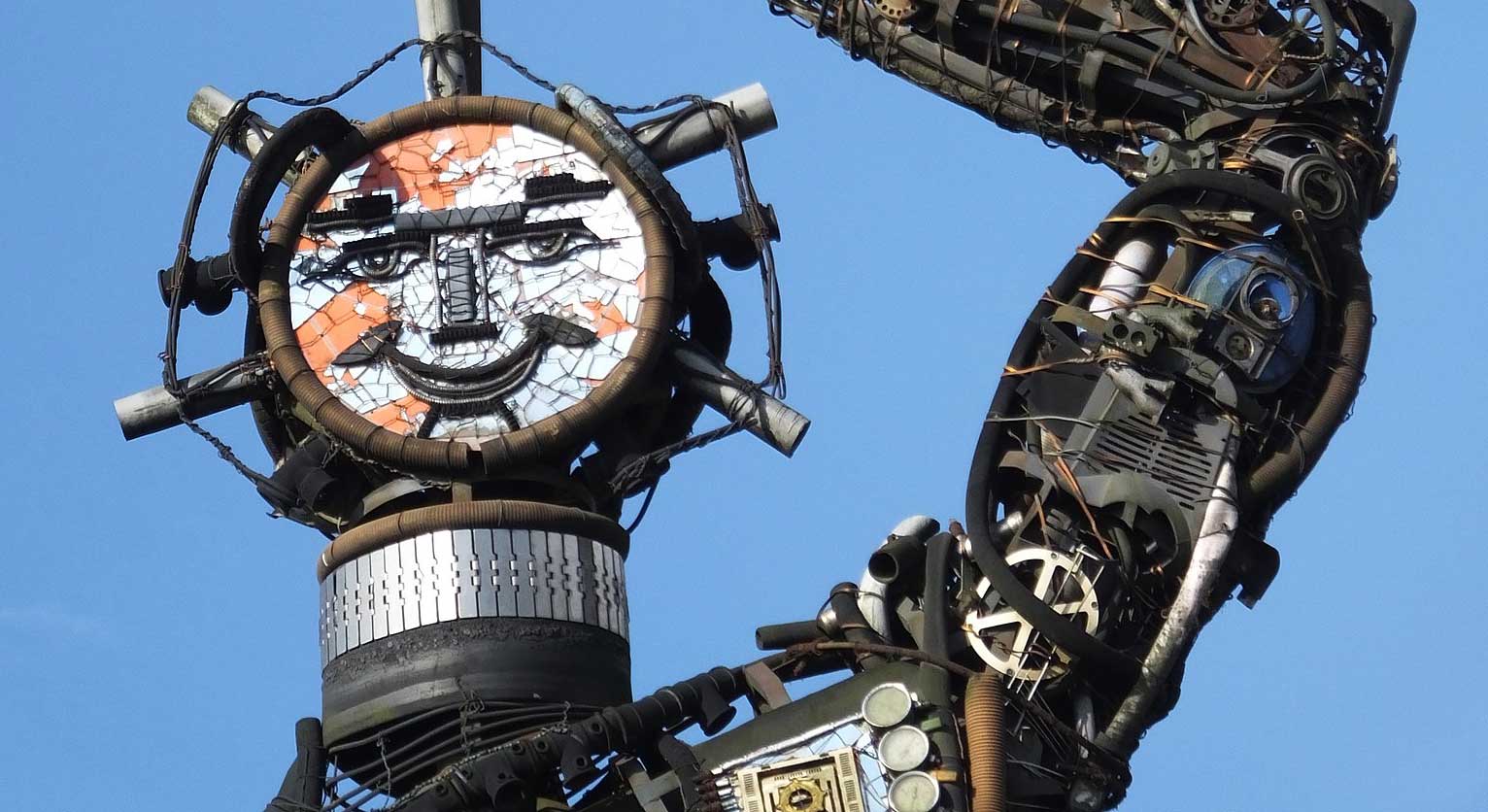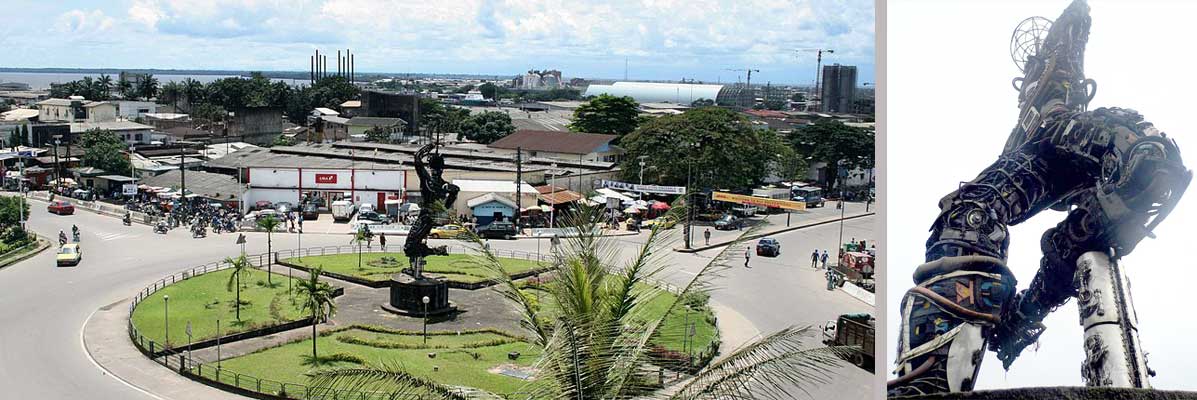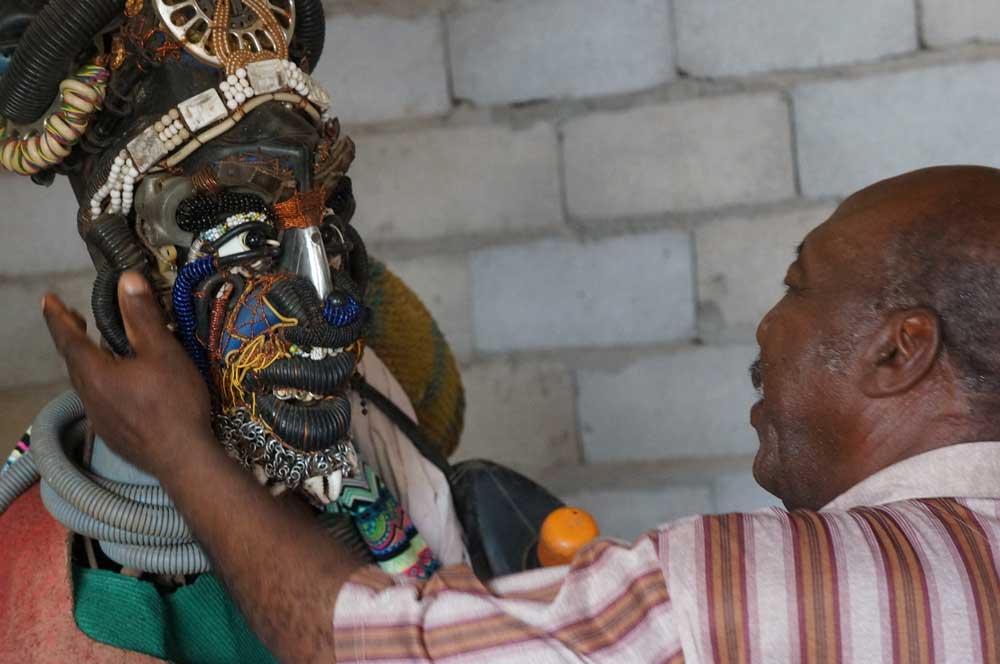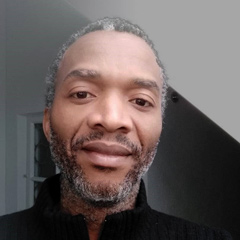Through its form, it reveals the modern urban context, a composite universe whose harmony is constantly negotiated in the logic of the delicate assemblages that characterizes the artist's technique. The work also reveals the socio-cultural mutations of which the artistic practice becomes an expression with its new form. Through the processes of recycling and assembling industrial waste, through the monumental appearance of a work whose silhouette recalls a human figure, through its installation on a roundabout, La Nouvelle Liberté brings together the elements of a manifesto of the transformation of cultural practices and particularly of the visual arts in the second half of the 20th century in Cameroon.

Screenshot from the entry about Douala on Wikipedia
This sculpture is special because of the context in which it was created. The commissioning of the work was part of the first projects of the very first and almost unique contemporary art center in Cameroon, doual'art (1991). The Centre was born in the aftermath of the adoption of the law on freedom of association (law No. 90-53 of December 1990). The approach to artistic promotion that it adopts is defined by the principles of artistic act-action-activism as the main modalities of intervention in the city of Douala. It is in this approach that doual'art commissioned the sculpture from Joseph Francis Sumégné.
Doual'art's artistic project SUD2017 (Link) is a clear expression of the freedoms to which Cameroonian society ardently aspires, according to the president of doual’art, Marilyn Douala Bell. She describes its context as follows: “while the project’s gestation began in 1981, after the election of Francois Mitterrand as president of France, the two principal triggers occurred in the 1990s in Cameroon: firstly, socio-political movements incited the people to seize the street and reclaim “democracy” and, secondly, there was the promulgation of December 1990 law authorized freedom association for the first time in this country” (I. Pensa & al., 2017, 9).
Nouvelle Liberté is one of the major works that marks the transformation of artistic practice in Cameroon which now focuses on the contemporary national society in its various historical, socio-cultural, political and economic aspects. The work takes a great conceptual dimension; it draws material from the field of negotiation and change of cultural meanings in the same context that inspires the image it reflects. For Sabine Breitwieser “for many this field has become the basic practice, focusing on actions and processes along the connecting line between the arts, everyday life, and politics” (A. Alberro & S. Buchmann,2006, 9-10).
Joseph Francis Sumégné explores the urban world both from the material and the conceptual perspective. According to Joana Danimbe (2021), the city is a field of experimentation that affects the work of this artist. The process of making the work and its title place the observer in a critical relationship with urban modernity. The sculptural work echoes the city in which it is erected. It echoes it by its constructed form through a process of assembling diverse heterogeneous elements, industrial waste (plastics, metals, alloys of all kinds) that the city has difficulty in absorbing.

Sumégné, Nouvelle Liberté, Detail (Creative Commons)
The difficulties posed by the management of industrial waste is only one aspect of the work, which questions the impact of the accelerated modernity of the mentalities of city dwellers, which Yakouba Konaté notes as new and characteristic in African cities (Assako, 2011, 103). In this context of modernity par excellence, it is difficult to guarantee the harmonious development of those who live there. The latent tribal and communal tensions in these cities are a sufficient proof of the fragility of this harmony. For example, the nickname "Nju Nju (evil spirit) of Deido” given to Sumégné's work highlights some aspects of the limits of collective integration posed by the cities. The artist reminds us that: “this negative designation is based on the strong protests voiced by native populations against La Nouvelle Liberté. After these first polemics, mainly concerned with aesthetical features of the sculpture, a violent controversy was raised by the media on the origins of the artist (who hails from the western part of Cameroon) taking the fold of an ethnic struggle between the indigenous people of Douala. For such reasons, La Nouvelle Liberté was officially inaugurated only eleven years later, during SUD 2017” (I. Pensa & als., op cit., 93).
The city of Douala, the economic capital of Cameroon, makes the facts of social and cultural transformation, industrialization and related issues in Cameroon remarkably appreciable. Douala is the most important port city in Cameroon and Central Africa. It is a city of great industrialization. The economic opportunities offered by the city make it a real national and international pole of attraction and an important migratory drop-off point as well. The city is therefore a center of great demographic concentration and mixing. It is reputed to be the most polluted city in Cameroon due to its industrial and economic activities and its human density. It is also the city most exposed to social implosion due to the high number of young people who find themselves in precariousness and in search of decent employment. The balance of urban life depends on the city's capacity to promote a process of integration which leads to the construction of a collective identity.

On the right: J.NicolasKondaYansa. Vue aérienne de Douala (Creative Commons).
This is the phenomenon that the image of Sumégné's work has succeeded in bringing about in Cameroon over the past twenty years. It has crossed the phase of rejection and critical questioning to become the object of collective appropriation and an emblem for the Douala people in particular and the Cameroonians in general. "By recovering rejected objects, the artist becomes by force of circumstances a full-fledged actor in the organization of urban life, sharing the basis of his innovative thinking on the relationship between cities, cultures, representations of working-class neighborhoods and environmental ecology. “In his thinking, the city is a place where the intimate (the family side, religion and its rites) and the universal (openness to other cultures within the city) meet” (Joana Danimbe, op cit., 33).
However, this collective identity is not given. There are permanent conflicts between rural and urban, rich and poor, order and anarchy, libertinism and freedom, civic-mindedness and uncivil behavior, etc. For politicians, however, national development is expressed through actions that are generally in vain and aimed at giving a 'modern' appearance to cities. It should be noted, however, that the urban ecosystem, on a social level, lives on the permanent 'daptaïsme[1]' (S. Andriamirado, 2002) of city dwellers in search of a balance between the socio-economic and political references of Western modernity and those relating to the various local customs that are superficially apprehended. In such a context, flourishing in the city takes its trajectory from inventive intuitions as demonstrated by Sumégné in the process of shaping La Nouvelle Liberté. The artist's bold work imposes itself on the city dwellers in the form of a new experience. He magnifies this experience through the novelty and singularity of the codes of representation of his artistic work. The elements offered by the city and used by the artist to create his works are chosen on the basis of two main values: they are true generators of ideas and they are inspirers of structures.
The verticality of Sumégne's work is evident at the Deido roundabout, which is one of the main entries of the city of Douala. The sculpture has a human silhouette and stands on a concrete pedestal. Its posture describes a movement whose balance is suggested by an asymmetrical gesture and a distribution of masses and volumes in relation to the vertical axis. The ascending tension of the monumental sculpture is supported by the base of the right foot, crosses the trunk, the head and ends on the globe which caps the upper end of the work. The movements described by the limbs make the sculpture even more dynamic. The bent left leg crosses the right leg at knee height from behind. The position of this leg structures the pelvis and the part above the knees of the figure in a truncated cone shape. The upper left arm is raised above the head to hold the globe and the right arm is bent and oriented as if to rest on the hip with the fist closed.

Steve Mvondo, NadègeNN: Sumégné, Nouvelle Liberté (Creative Commons left / right)
A dynamic posture that gives the work pride of place, but also conveys a sense of fragility. This proud appearance is further suggested by the expressiveness of the statue's circular head, which draws a smiling face or a sun. The attention paid to the elegance of the statue can be seen in the details of the adornment on the work. The neck is outlined with a grey band that acts as a necklace. The same band is used to define the belt worn by the figure. A sort of waistcoat covers the figure's torso and contributes to the attention to the adornment being a characteristic detail of the work. The care given to the detailed elaboration of this kind of waistcoat enhances the drawing, engraving, upholstering, painting and sculpting skills, which allow the artist to easily interweave the traditional with the modern and the modern with the traditional through the technique. The technical game describes a stirring of the memory in which Sumégné crosses the past and the present in a delicate process of balance, harmony and construction of a work of art that the work gives to appreciate.
The accelerated modernity of mentalities is accompanied by deviations rather than guaranteeing the expression of freedoms favorable to the construction of a collective identity and a more social dimension of the meaning of development in the cities. The Cameroonian city must cease to be a mere showcase for political celebration / instrumentalization and a springboard for socio-professional accomplishment for city dwellers and become the real space for a new life, a sustainable life. Art, as illustrated by Nouvelle Liberté, has embarked on this path by investing itself materially and conceptually in the urban environment: The contemporary art scene in Cameroon's economic capital, which is one of the most active and committed in urban Africa, is itself in constant movement. Objects, ideas and practices are given new meanings on a daily basis, often politically, and which, like “La Nouvelle Liberté", highlights questions of identity, the right to speak and self-determination (D. Malaquais, 2006, 122).
Published 2020
References
- Alberro Alexander & Buchmann Sabeth. 2006. Art after conceptual art, Vienna, Austria, Generali Foundation, pp.9-10
- ANDRIAMIRADO Virginie. 2002. « Tout est prétexte à la création », entretien avec Ndary Lo, in « Africultures, n° 48 » Éditions l’Harmattan, 63-67
- Assako Assako PH.S. 2011, l’art au cameroun du XXe au début du XXIe siècle : étude des expressions sculpturales en milieu urbain, thèse de Doctorat/Ph.D. en histoire de l’art, Université de Yaoundé
- Danimbe Joana.2021. Joseph Francis Sumegne, le méditoire du Jala’a, Paris, Ed. Fondation Blachère
- Dominique Malaquais, « Une nouvelle liberté ? Art et politique urbaine à Douala (Cameroun) », Afrique & histoire 2006/1 (vol. 5), p. 111-134.
- Lagnier Sylvie. 2001. Sculpture et espace urbain en France, histoire de l’instauration d’un dialogue 1951-1992, Paris, Ed. l’Harmattan
- Pensa Iolanda & als. 2017. Public art in Africa, Genève, Metis Presses
[1] Vocabulary borrowed from the Senegalese sculptor NDARY LO, who designates "daptaïsme" as a philosophical principle on which his art is based, and which consists in adapting to everything and in all circumstances. The artist collects salvaged objects that he diverts and manipulates according to the circumstances of his creation. So, the urban ecosystem adapts and cobbles together alternative solutions on a day-to-day basis.

The artist working in his studio 2019 (Photo Ernst Wagner)






